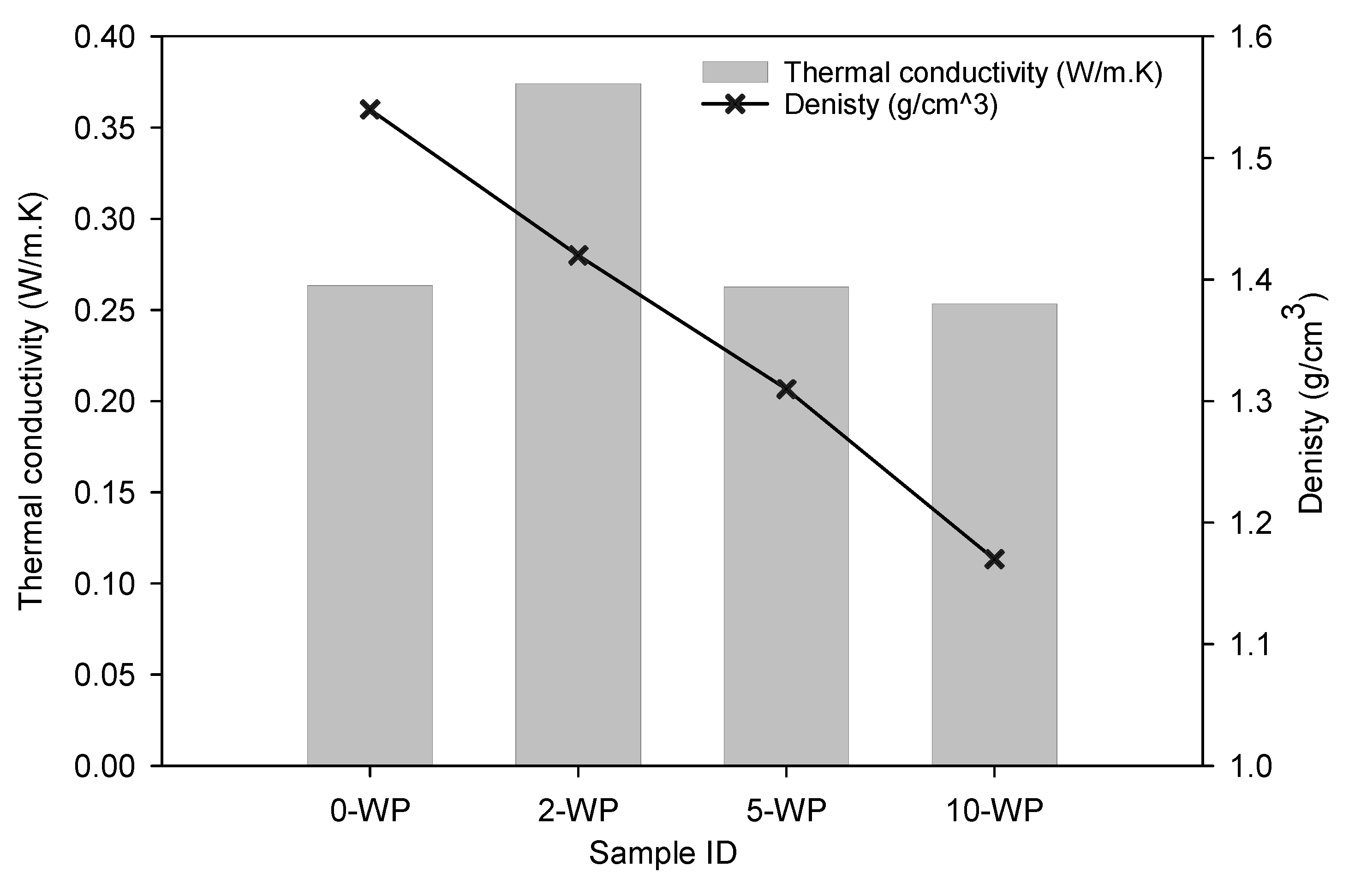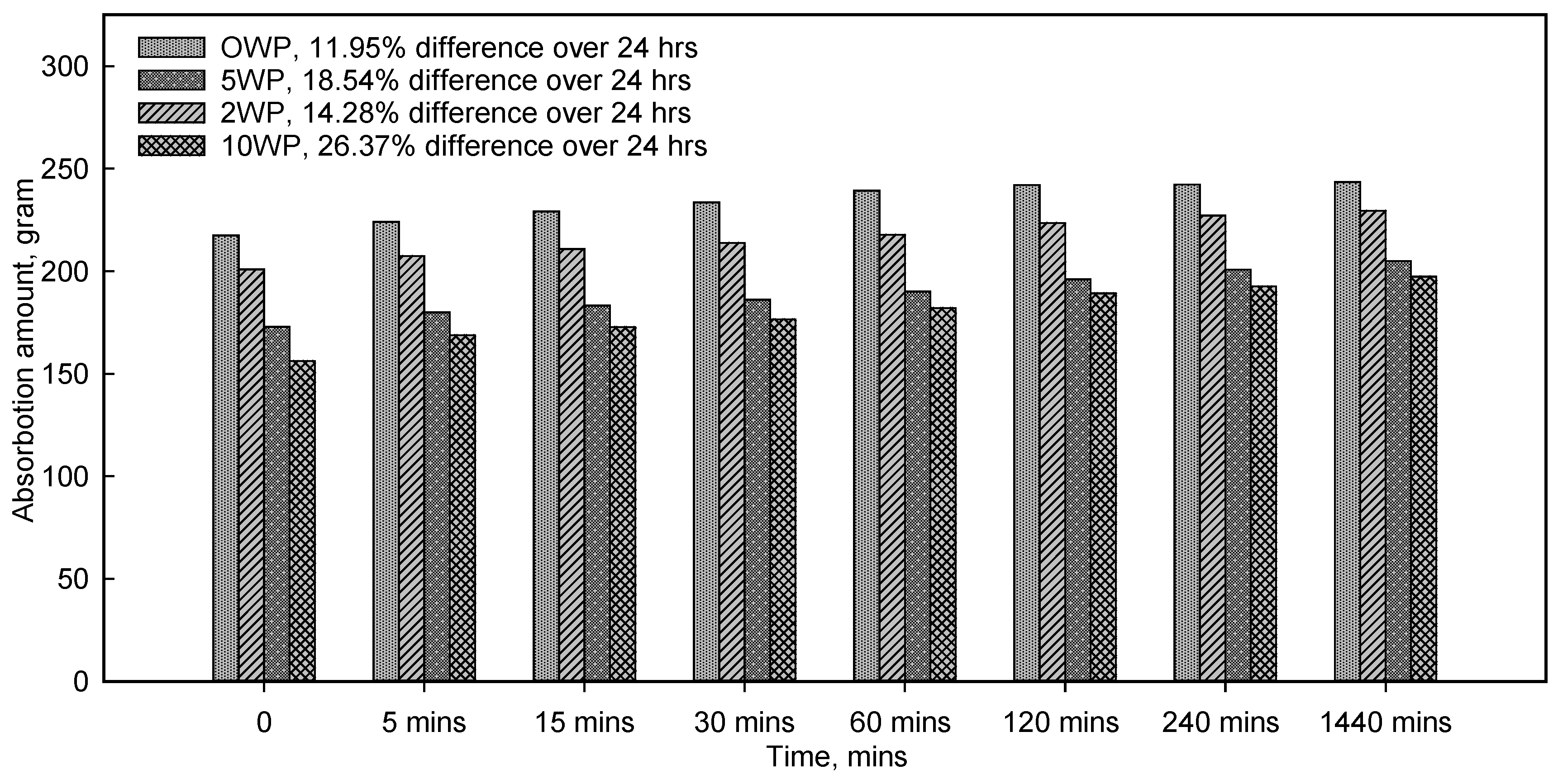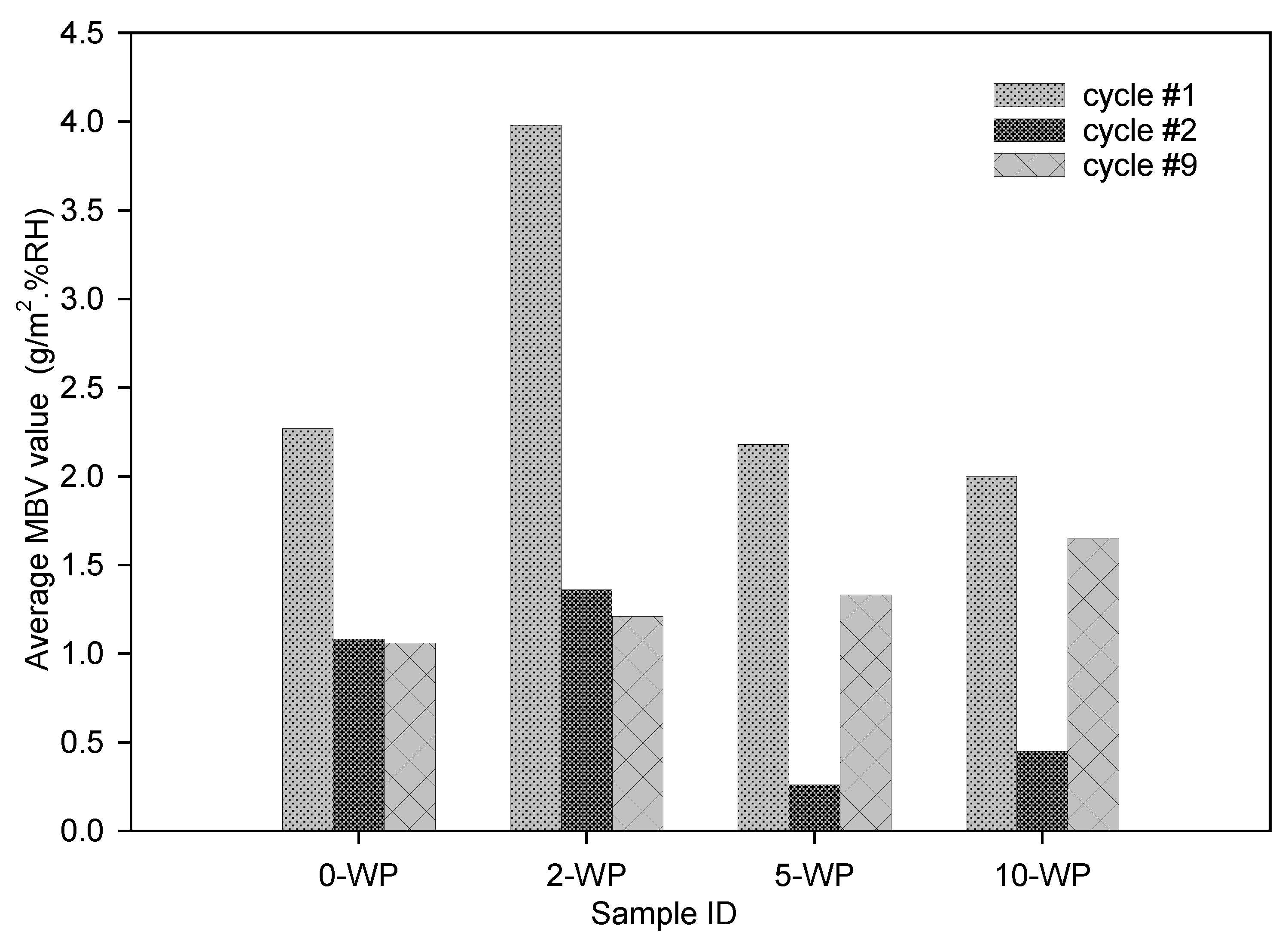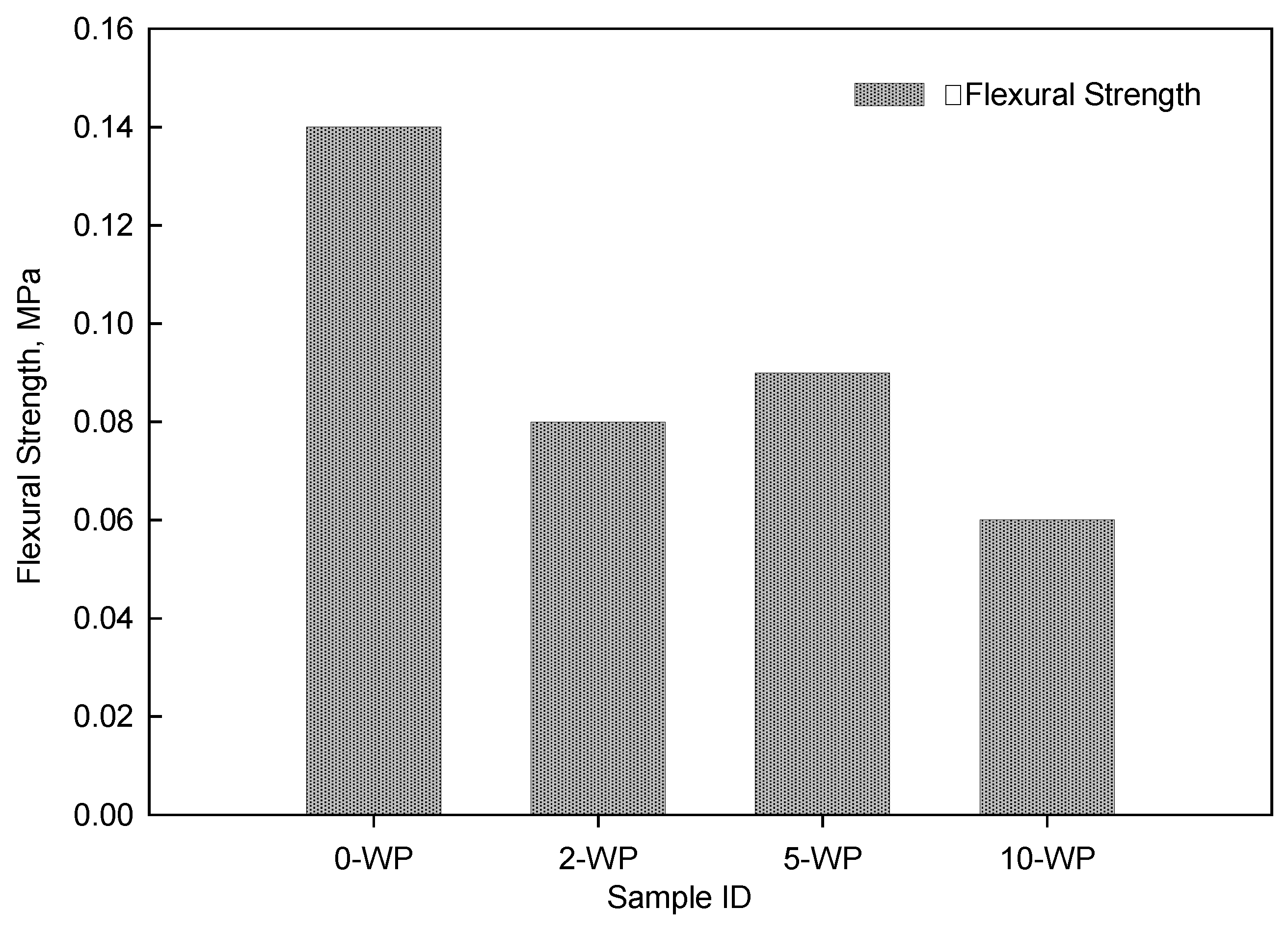Exploring the Use of Wood Pellets as a Sustainable Alternative for Indoor Insulation
Abstract
:1. Introduction
- Characterizing wood pellets’ waste materials based on physical and chemical properties observed in the laboratory test;
- Defining standards for developing and manufacturing sustainable high-performance bio-based insulation products with wood pellets added;
- Investigating the physical, mechanical, and thermal properties of the wood pellets blended with a high-performance insulation product in the laboratory to explore the optimized level of wood pellets for the composites’ internal matrix;
- Utilizing wood pellets in building insulation is a new vision to recycle more waste.
2. Related Work
3. Materials and Methods
3.1. Samples’ Composition
3.2. Samples’ Preparation
3.3. Testing Methods
3.3.1. Flow Table Test
3.3.2. Thermal Conductivity
3.3.3. Capillary Water Absorption Test
3.3.4. Moisture Buffer Value Test
3.3.5. Flexural Strength Test
3.3.6. Compressive Strength Test
4. Results and Discussion
4.1. Flow Table Test Results
4.2. Thermal Conductivity Test Results
4.3. Capillary Water Absorption Test Results
4.4. Moisture Buffer Value Test Results
4.5. Flexural Strength Test Results
4.6. Compressive Strength Test Results
5. Discussion and Conclusions
- Effect of wood pellet shavings on density: positive correlation. The research observes a visible correlation between the increase in wood pellet shavings and a reduction in density among different samples. This is consistent with expectations as wood pellet shavings are generally lighter than the matrix materials;
- Impact on thermal conductivity: Surprisingly, the thermal conductivity, contrary to the literature suggestions, and the decrease in density did not significantly impact thermal conductivity. Even with higher porosity in samples with more wood pellet shavings, the improvement in thermal conductivity was minimal. This unexpected result challenges conventional assumptions;
- Mechanical properties and porosity: Higher proportions of wood pellet shavings reduced mechanical properties, likely due to increased porosity. This aligns with the idea that poor adhesion of wood pellet shavings to the inner matrix could compromise overall strength;
- Compression testing and water capillary test: Despite the general trend of reduced mechanical properties, the 2WP composite showed promise in compression testing, outperforming other mixtures. The wood-based mixture demonstrated a significant capacity to absorb water during the water absorption test, as seen in the water capillary test. This property should be considered in practical applications;
- MBV results and flow table test: While MBV results were good compared to guidelines, the 100 × 100 × 35 mm samples did not perform as well as expected. Excessive moisture during the mixing stage, influenced by the flow table test, may have negatively impacted results;
- Flow table test challenges: The results negatively affected the experiment, leading to increased water absorption by samples with wood pellet additions. The necessity to meet minimum consistency requirements impacted the overall performance;
- Workability and consistency measurement: The research suggests that the mixture with wood pellet additions, especially 10WP, was in a workable state for casting before the flow table test. This highlights a potential issue with the current method of measuring consistency. The study recommends exploring new methods to measure the required consistency of wood-based bio-mixture;
- Wood fiber treatment: The research emphasizes the importance of improving adhesion between wood pellet fibers and the inner matrix to reduce porosity. Treating wood fibers could be a critical factor in enhancing the mechanical strength of wood-based bio-composites;
- Cost efficiency: A high-performance wood pallet insulation product using wood pellet shavings, sand, lime, and clay can be influenced by various factors. These factors include material costs, manufacturing processes, energy efficiency, durability, and overall performance. Achieving the ideal wood shavings ratio requires experimentation to balance thermal properties and structural integrity. Considerations of market demand, environmental impact, and adherence to regulations also play a role. Optimizing manufacturing processes for scalability and efficiency can contribute to overall cost-effectiveness.
Author Contributions
Funding
Informed Consent Statement
Data Availability Statement
Acknowledgments
Conflicts of Interest
References
- Cabeza, L.; Rincón, L.; Vilariño, V.; Pérez, G.; Castell, A. Life cycle assessment (LCA) and life cycle energy analysis (LCEA) of buildings and the building sector: A review. Renew. Sustain. Energy Rev. 2014, 2, 9394–9416. [Google Scholar] [CrossRef]
- Vinolas, B.; Casanovas-Rubio, M.; Silva, A.; Roa, J.B.; Andrade, A.; Carvalho, F.; Gonçalves, H.; Rocha, H.J.A. Flexural Strength of High-Performance Soil-Cement: A New, Alternative, Sustainable Construction Material. Sustainability 2023, 15, 15369. [Google Scholar] [CrossRef]
- Moujoud, Z.; Harrati, A.; Manni, A.; Naim, A.; El Bouari, A.; Tanane, O. Study of fired clay bricks with coconut shell waste as a renewable pore-forming agent: Technological, mechanical, and thermal properties. J. Build. Eng. 2023, 68, 06107. [Google Scholar] [CrossRef]
- Wang, Z.; Wang, D. Can Paper Waste Be Utilised as an Insulation Material in Response to the Current Crisis. Sustainability 2023, 15, 15939. [Google Scholar] [CrossRef]
- Ledhem, A.; Dheilly, R.; Benmalek, M.; Quéneudec, M. Properties of wood-based composites formulated with aggregate industry waste. Constr. Build. Mater. 2000, 14, 341–350. [Google Scholar] [CrossRef]
- Mujalli, M.; Dirar, S.; Mushtaha, E.; Hussien, A.; Maksoud, A. Evaluation of the Tensile Characteristics and Bond Behaviour of Steel Fibre-Reinforced Concrete: An Overview. Fibers 2022, 10, 104. [Google Scholar] [CrossRef]
- Jannat, N.; Al-Mufti, R.; Hussien, A.; Abdullah, B.; Cotgrave, A. Influences of agro-wastes on the physico-mechanical and durability properties of unfired clay blocks. Constr. Build. Mater. 2022, 318, 126011. [Google Scholar] [CrossRef]
- Hassan, A.; Abdeen, A.; Mohamed, A.; Elboshy, B. Thermal performance analysis of clay brick mixed with sludge and agriculture waste. Constr. Build. Mater. 2022, 344, 128267. [Google Scholar] [CrossRef]
- Lelievre, D.; Colinart, T.; Glouannec, P. Hygrothermal behavior of bio-based building materials including hysteresis effects: Experimental and numerical analyses. Energy Build. 2014, 84, 617–627. [Google Scholar] [CrossRef]
- Cetiner, I.; Shea, A. Wood waste as an alternative thermal insulation for buildings. Energy Build. 2018, 168, 374–384. [Google Scholar] [CrossRef]
- Palumbo, M.; Lacasta, A.; Giraldo, M.; Haurie, L.; Correal, E. Bio-based insulation materials and their hygrothermal performance in a building envelope system (ETICS). Energy Build. 2018, 174, 147–155. [Google Scholar] [CrossRef]
- Hui, S.; Ma, T. Analysis of environmental performance of indoor living walls using embodied energy and carbon. Int. J. Low-Carbon Technol. 2017, 12, 67–74. [Google Scholar] [CrossRef]
- Ben-Alon, L.; Loftness, V.; Harries, K.; Hameen, E. Life cycle assessment (LCA) of natural vs conventional building assemblies. Renew. Sustain. Energy Rev. 2021, 144, 110951. [Google Scholar] [CrossRef]
- Rode, A.; Peuhkuri, R.; Hansen, K.; Time, B.; Svennberg, K.; Arfvidsson, J.; Ojanen, T. NORDTEST project on moisture buffer value of materials. In Proceedings of the AIVC 26th Conference: Ventilation in Relation to the Energy Performance of Buildings, Air Infiltration and Ventilation, Brussels, Belguim, 21–23 September 2005. [Google Scholar]
- Faria, P.; Santos, T.; Aubert, J. Experimental characterization of an earth eco-efficient plastering mortar. J. Mater. Civ. Eng. 2016, 28, 04015085. [Google Scholar] [CrossRef]
- Charai, M.; Sghiouri, H.; Mezrhab, A.; Karkri, M. Thermal insulation potential of non-industrial hemp (Moroccan cannabis sativa L.) fibers for green plaster-based building materials. J. Clean. Prod. 2021, 292, 126064. [Google Scholar] [CrossRef]
- Czajkowski, Ł.; Kocewicz, R.; Weres, J.; Olek, W. Estimation of Thermal Properties of Straw-Based Insulating Panels. Materials 2022, 15, 1073. [Google Scholar] [CrossRef] [PubMed]
- Jannat, N.; Al-Mufti, R.; Hussien, A.; Abdullah, B.; Cotgrave, A. Utilisation of nut shell wastes in brick, mortar and concrete: A review. Constr. Build. Mater. 2021, 293, 123546. [Google Scholar] [CrossRef]
- Gameiro, A.; Silva, A.; Faria, P.; Grilo, J.; Branco, T.; Veiga, R.; Velosa, A. Physical and chemical assessment of lime–metakaolin mortars: Influence of binder: Aggregate ratio. Cem. Concr. Compos. 2014, 45, 264–271. [Google Scholar] [CrossRef]
- Limam, A.; Zerizer, A.; Quenard, D.; Sallee, H.; Chenak, A. Experimental thermal characterization of bio-based materials (Aleppo Pine wood, cork and their composites) for building insulation. Energy Build. 2016, 116, 89–95. [Google Scholar] [CrossRef]
- Millogo, Y.; Morel, J.; Aubert, J.; Ghavami, K. Experimental analysis of Pressed Adobe Blocks reinforced with Hibiscus cannabinus fibers. Constr. Build. Mater. 2014, 52, 71–78. [Google Scholar] [CrossRef]
- Ranesi, A.; Faria, P.; Correia, R.; Freire, M.; Veiga, R.; Gonçalves, M. Gypsum Mortars with Acacia dealbata Biomass Waste Additions: Effect of Different Fractions and Contents. Buildings 2022, 12, 339. [Google Scholar] [CrossRef]
- Bederina, M.; Marmoret, L.; Mezreb, K.; Khenfer, M.; Bali, A.; Quéneudec, M. Effect of the addition of wood shavings on thermal conductivity of sand concretes: Experimental study and modelling. Constr. Build. Mater. 2007, 21, 66. [Google Scholar] [CrossRef]
- Divya, H.; Jeevan, T.; Ashrith, H.; Rudresh, B. Effect of wood filler on the mechanical and thermal behavior of polypropylene/short glass/short carbon fiber-reinforced hybrid composites. J. Braz. Soc. Mech. Sci. Eng. 2022, 44, 265. [Google Scholar] [CrossRef]
- Kumar, V.; Kumar, A.; Prasad, B. Mechanical behavior of non-silicate based alkali-activated ground granulated blast furnace slag. Constr. Build. Mater. 2019, 198, 494–500. [Google Scholar] [CrossRef]
- EN 1015-2:1999; Methods of Test for Mortar for Masonry—Part 2: Bulk Sampling of Mortars and Preparation of Test Mortars. British Standards Institution: London, UK, 1999.
- EN 12664:2001; Thermal Performance of Building Materials and Products—Determination of Thermal Resistance by Means of Guarded Hot Plate and Heat Flow Meter Methods—Dry and Moist Products of Medium and Low Thermal Resistance. British Standards Institution: London, UK, 2001.
- EN 12667:2001; Thermal Performance of Building Materials and Products—Determination of Thermal Resistance by Means of Guarded Hot Plate and Heat Flow Meter Methods—Products of High and Medium Thermal Resistance. British Standards Institution: London, UK, 2001.
- EN 12939:2001; Thermal Performance of Building Materials and Products—Determination of Thermal Resistance by the Guarded Hot Plate Method and the Fluxmetric Method—Thick Products with High and Medium Thermal Resistance. British Standards Institution: London, UK, 2001.
- EN 1015-3:1999; Methods of Test for Mortar for Masonry—Part 3: Determination of Consistence of Fresh Mortar (By Flow Table). British Standards Institution: London, UK, 1999.
- Pásztory, Z. An overview of factors influencing thermal conductivity of building insulation materials. J. Build. Eng. 2021, 44, 102604. [Google Scholar]
- EN 1015-11:2019; Methods of Test for Mortar for Masonry—Part 11: Determination of Flexural and Compressive Strength of Hardened Mortar. British Standards Institution: London, UK, 2019.
- Bederina, M.; Gotteicha, M.; Belhadj, B.; Dheily, R.; Khenfer, M.; Queneudec, M. Drying shrinkage studies of wood sand concrete–Effect of different wood treatments. Constr. Build. Mater. 2012, 36, 1066–1075. [Google Scholar] [CrossRef]
- Palumbo, M.; Lacasta, A.; Holcroft, N.; Shea, A.; Walker, P. Determination of hygrothermal parameters of experimental and commercial bio-based insulation materials. Constr. Build. Mater. 2016, 124, 269–275. [Google Scholar] [CrossRef]
- Bederina, M.; Hadjoudja, M.; Dheilly, R.; Makhloufi, Z.; Quéneudec, M. Combined effect of sand grain size and contents of wood and filler on the physicomechanical properties and the microstructure of lightweight sand concrete. J. Adhes. Sci. Technol. 2016, 30, 1391–1412. [Google Scholar] [CrossRef]
- Abu-Jdayil, B.; Mourad, A.; Hittini, W.; Hassan, M.; Hameedi, S. Traditional, state-of-the-art and renewable thermal building insulation materials: An overview. Constr. Build. Mater. 2019, 214, 709–735. [Google Scholar] [CrossRef]
- Al Rim, K.; Ledhem, A.; Douzane, O.; Dheilly, R.; Queneudec, M. Influence of the proportion of wood on the thermal and mechanical performances of clay-cement-wood composites. Cem. Concr. Compos. 1999, 21, 269–276. [Google Scholar] [CrossRef]
- Harada, T.; Hirata, T.; Setoyama, K.; Ohkoshi, M. Utilization of wood and its feasibility as ecomaterials. In Ecomaterials; Elsevier: Amsterdam, The Netherlands, 1994; pp. 677–680. [Google Scholar]
- Winandy, J.; Morrell, J. Improving the utility, performance, and durability of wood-and bio-based composites. Ann. For. Sci. 2017, 74, 25. [Google Scholar] [CrossRef]









| Materials | Description |
|---|---|
| Clay | Reddish-brown clay was purchased from Al Diyar Bricks and Cladding Brick Slip Manufacturer and Supplier from Sharjah, U.A.E. A hydrometer analysis was performed on the clay to obtain its soil classification as silty clay with 10% sand. The grain-size distribution for the clay was measured via the hydrometer test. |
| Sand | Fine sand was used for the composite, purchased from local supplier Al Diyar Bricks and Cladding Brick Slip Manufacturer and Supplier, U.A.E. The sand was stored inside the lab to ensure no excess moisture was present in the sand. |
| Lime | Hydrated air lime was added to the composite due to its stabilizing effects. The hydrated air lime was purchased from the Emirates Lime Factory Manufacturer and Supplier, Abu Dhabi, U.A.E. |
| Wood Pellets | The wood pellets used were purchased from a local supplier, Saleh International Building Materials, Dubai, U.A.E. Wood pellets were grinded and sieved to have a controlled particle size between 1.18 mm and 2 mm. |
| Sample | Sand | Lime | Clay | Wood Pellets | Water | Wood Molds 100 × 100 × 35 mm3 | Prismatic Samples 40 × 40 × 160 mm3 | ||||
|---|---|---|---|---|---|---|---|---|---|---|---|
| % | g | % | g | % | g | % | g | mL | 3 | 9 | |
| 0WP | 88.66 | 860 | 10.31 | 100 | 1.03 | 10 | 0 | 0 | 240 | 3 | 9 |
| 2WP | 88.66 | 860 | 10.31 | 100 | 1.03 | 10 | 2 | 19.4 | 295 | 3 | 9 |
| 5WP | 88.66 | 860 | 10.31 | 100 | 1.03 | 10 | 5 | 43.5 | 345 | 3 | 9 |
| 10WP | 88.66 | 860 | 10.31 | 100 | 1.03 | 10 | 10 | 97 | 480 | 3 | 9 |
| Material | Wood Pellet Shavings (g) | Water Volume (mL) | Consistency (mm) | Difference (mL) | % Absorption of Water by Wood Shavings |
|---|---|---|---|---|---|
| 0WP | 0 | 240 | 152 | 0 | N/A |
| 2WP | 19.4 | 295 | 154 | 45 | 232% |
| 5WP | 43.5 | 345 | 155 | 105 | 241% |
| 10WP | 97 | 480 | 153 | 240 | 247% |
| Sample | Capillary Water Absorption Coefficient |
|---|---|
| 0WP | 0.0162 kg/m2S0.5 |
| 2WP | 0.0179 kg/m2S0.5 |
| 5WP | 0.0200 kg/m2S0.5 |
| 10WP | 0.0258 kg/m2S0.5 |
| Sample ID | 0′ | 1D | 7D | 8D | 13D | 14D | % Difference |
|---|---|---|---|---|---|---|---|
| 0WP | 217.45 | 243.43 | 246.12 | 246.36 | 247.26 | 274.26 | 13.71% |
| 2WP | 200.86 | 229.53 | 234.77 | 235.20 | 237.43 | 237.54 | 18.26% |
| 5WP | 172.94 | 205.00 | 211.93 | 212.48 | 215.11 | 215.23 | 24.45% |
| 10WP | 156.27 | 197.47 | 205.69 | 205.69 | 207.58 | 207.70 | 32.92% |
| Sample | Moisture Buffering Value (MBV) (g/M2. % RH) | Coefficient of Variation % (COV) |
|---|---|---|
| 0WP | 1.06 | 16 |
| 2WP | 1.21 | 4 |
| 5WP | 1.33 | 7 |
| 10WP | 1.65 | 9 |
| Sample | Moisture Buffering Value (MBV) (g/M2. % RH) MBV Results First Cycle | Moisture Buffering Value (MBV) (g/M2. % RH) MBV Results Stable Cycle |
|---|---|---|
| 0A | 3.23 | 1.18 |
| 0B | 0.59 | 0.86 |
| 0C | 3.00 | 1.14 |
| 2A | 5.18 | 1.18 |
| 2B | 5.18 | 1.27 |
| 2C | 1.59 | 1.18 |
| 5A | 1.95 | 1.41 |
| 5B | 1.91 | 1.23 |
| 5C | 2.68 | 1.36 |
| 10A | 2.36 | 1.82 |
| 10B | 2.95 | 1.55 |
| 10C | 0.68 | 1.59 |
Disclaimer/Publisher’s Note: The statements, opinions and data contained in all publications are solely those of the individual author(s) and contributor(s) and not of MDPI and/or the editor(s). MDPI and/or the editor(s) disclaim responsibility for any injury to people or property resulting from any ideas, methods, instructions or products referred to in the content. |
© 2023 by the authors. Licensee MDPI, Basel, Switzerland. This article is an open access article distributed under the terms and conditions of the Creative Commons Attribution (CC BY) license (https://creativecommons.org/licenses/by/4.0/).
Share and Cite
Hussien, A.; Maksoud, A.; Abdeen, A.; Nofal, E. Exploring the Use of Wood Pellets as a Sustainable Alternative for Indoor Insulation. Sustainability 2024, 16, 25. https://doi.org/10.3390/su16010025
Hussien A, Maksoud A, Abdeen A, Nofal E. Exploring the Use of Wood Pellets as a Sustainable Alternative for Indoor Insulation. Sustainability. 2024; 16(1):25. https://doi.org/10.3390/su16010025
Chicago/Turabian StyleHussien, Aseel, Aref Maksoud, Ahmed Abdeen, and Eslam Nofal. 2024. "Exploring the Use of Wood Pellets as a Sustainable Alternative for Indoor Insulation" Sustainability 16, no. 1: 25. https://doi.org/10.3390/su16010025
APA StyleHussien, A., Maksoud, A., Abdeen, A., & Nofal, E. (2024). Exploring the Use of Wood Pellets as a Sustainable Alternative for Indoor Insulation. Sustainability, 16(1), 25. https://doi.org/10.3390/su16010025








